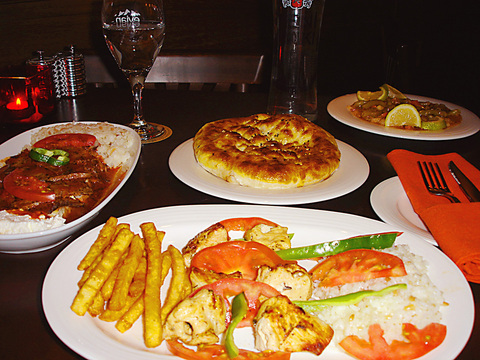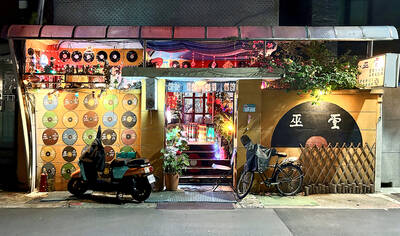In the movie Troy, Odysseus hatches a dastardly plan to breach the besieged city's defenses. The Greeks build a wooden horse within which Achilles and a batch of soldiers hide, and the unsuspecting people of Troy take the horse into the city with dire consequences.
The plot works, Troy falls, and the movie suggests that this was the birth of the Greek nation.
Troy is now in Turkey.

PHOTO: STEVE PRICE, TAIPEI TIMES
Marketing savvy Timucin Ozcan named his new restaurant Truva, the Turkish word for Troy, and uses the Trojan horse as its logo. "I wanted to open a restaurant that reflects the true nature of the Turkish people," he said.
Truva has been open three months and has attracted a lot of local publicity. Ozcan brought in two Turkish chefs and designed the menu to reflect different types of cuisine from his native country.
A new homestyle cooking section will be added to the menu this month to supplement the current selection of Turkish food.
The decor is stylish, with atmospheric lighting, dark wooden tables and chairs. Throughout the restaurant there are references to Turkey such as a traditional dress hung in a glass case above the staircase, the national flag attached to the ceiling and an Ottoman-style rug hung on the wall.
Appetizers include spicy vegetable salad, tarator (which is yoghurt curd topped with garlic and walnuts) and egg plant salad. The main course options are dominated by kebabs and pita bread pizza.
The most famous kebab, or perhaps the most infamous, is the doner kebab. In many European cities it is associated with greasy sidewalk stalls serving up slivers of stringy meat on a thin, hard pita bread.
Truva, however, presents the doner kebab in a more traditional way. The beef that is used to form the large rotating tower of meat is marinated for one day in yoghurt and herbs, including mint. Slices are carved off and served on a soft herby pita bread. The dish is accompanied with homemade sour yoghurt. The slices of beef although cooked through are surprisingly tender, and a dollop of yoghurt augments the dish into a mouthwatering treat.
Dessert includes Turkish ice cream made using orchid root: the resulting texture is thick and creamy.
Truva has a wide selection of wines and and serves Raki, a Turkish liquor that packs a punch and has an intense licorice flavor.

The Lee (李) family migrated to Taiwan in trickles many decades ago. Born in Myanmar, they are ethnically Chinese and their first language is Yunnanese, from China’s Yunnan Province. Today, they run a cozy little restaurant in Taipei’s student stomping ground, near National Taiwan University (NTU), serving up a daily pre-selected menu that pays homage to their blended Yunnan-Burmese heritage, where lemongrass and curry leaves sit beside century egg and pickled woodear mushrooms. Wu Yun (巫雲) is more akin to a family home that has set up tables and chairs and welcomed strangers to cozy up and share a meal

Dec. 8 to Dec. 14 Chang-Lee Te-ho (張李德和) had her father’s words etched into stone as her personal motto: “Even as a woman, you should master at least one art.” She went on to excel in seven — classical poetry, lyrical poetry, calligraphy, painting, music, chess and embroidery — and was also a respected educator, charity organizer and provincial assemblywoman. Among her many monikers was “Poetry Mother” (詩媽). While her father Lee Chao-yuan’s (李昭元) phrasing reflected the social norms of the 1890s, it was relatively progressive for the time. He personally taught Chang-Lee the Chinese classics until she entered public

Last week writer Wei Lingling (魏玲靈) unloaded a remarkably conventional pro-China column in the Wall Street Journal (“From Bush’s Rebuke to Trump’s Whisper: Navigating a Geopolitical Flashpoint,” Dec 2, 2025). Wei alleged that in a phone call, US President Donald Trump advised Japanese Prime Minister Sanae Takaichi not to provoke the People’s Republic of China (PRC) over Taiwan. Wei’s claim was categorically denied by Japanese government sources. Trump’s call to Takaichi, Wei said, was just like the moment in 2003 when former US president George Bush stood next to former Chinese premier Wen Jia-bao (溫家寶) and criticized former president Chen

President William Lai (賴清德) has proposed a NT$1.25 trillion (US$40 billion) special eight-year budget that intends to bolster Taiwan’s national defense, with a “T-Dome” plan to create “an unassailable Taiwan, safeguarded by innovation and technology” as its centerpiece. This is an interesting test for the Chinese Nationalist Party (KMT), and how they handle it will likely provide some answers as to where the party currently stands. Naturally, the Lai administration and his Democratic Progressive Party (DPP) are for it, as are the Americans. The Chinese Communist Party (CCP) is not. The interests and agendas of those three are clear, but